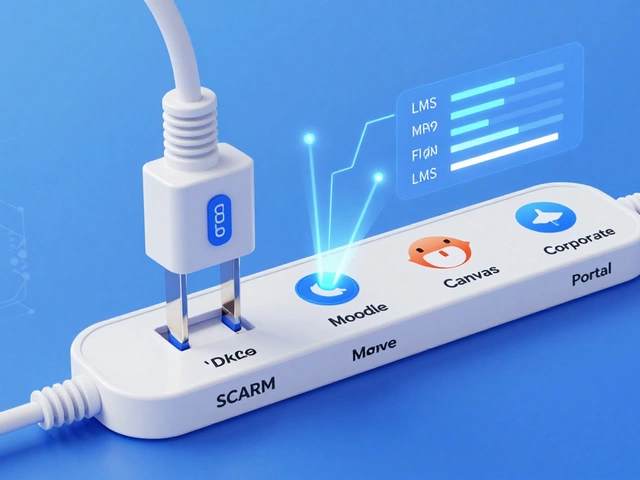Grammar rules are important, but have you ever met someone who could ace every worksheet yet freeze up in a real conversation? Turns out, most people pick up English faster when they talk it out right from the start, fumbles and all.
If you're teaching English, focusing on speaking right away sets the tone. People remember what they say out loud—the same way Fletcher learned his first words by repeating and playing, not filling in blanks. Studies show that direct practice, especially in real-life situations, helps words stick more than endless grammar drills.
Want better results? Ditch the perfect sentences for now. Encourage honest conversation, even if students make mistakes. When learners try, mess up, laugh, and try again, they're actually rewiring their brains for real communication. That's the kind of progress you can hear, not just grade on paper.
- Why Speaking Comes First
- Real-World Learning Beats Textbooks
- Role of Mistakes and Corrections
- Adapting to Different Learners
- Tech Tools and Modern Tricks
Why Speaking Comes First
You know the old school way of learning English—memorizing lists and sinking into grammar drills? That’s not how people naturally learn a language. Babies say their first words long before they recognize the alphabet or figure out sentence structure. Speaking, hands down, is our brains’ main door to new languages.
Everyday conversation fires up multiple areas of the brain at once. Neuroscientists at the University of Edinburgh found that real communication boosts memory and makes learners bolder with new words. It’s no wonder that students in English speaking courses who practice talking from day one often gain confidence three times faster than those who start with grammar rules.
Here’s some data that drive the point home:
| Method | Average Months to Basic Conversation |
|---|---|
| Speaking-focused | 6 |
| Grammar-first | 18 |
Bold, right? When students speak from the get-go, they reach basic conversational skills almost a year faster.
- Speaking practice helps learners make mistakes and fix them in real time.
- It builds listening skills without needing perfect grammar.
- Quick wins in conversation keep students motivated when lessons get tough.
If the goal is to actually use English in the real world, it just makes sense to lead with speaking. That’s how language lives and breathes in real life—not on a page.
Real-World Learning Beats Textbooks
Most people who sign up for English teaching want one thing: to speak and understand real English in everyday moments. That's tough to get from a textbook alone. Sure, textbooks lay out grammar rules and lists of words, but they can’t teach what it’s like to chat with someone at a coffee shop or handle a fast-talking waiter.
Research backs this up. According to a Cambridge University survey in 2023, students in programs using real-world activities (like role-play and speaking tasks) improved their speaking confidence two times faster than those who learned mainly from books.
Here are some practical ways to get more real-world English into lessons:
- Set up role-plays—ordering food, asking for directions, job interviews.
- Take short trips with learners: practice small talk in stores, ask questions on the street, or even just chat in the schoolyard.
- Use video clips or audio from real conversations, not just scripted dialogues.
- Get learners to record voice notes to family or friends in English.
It’s also worth looking at the numbers. Teachers using more practical activities see stronger results:
| Approach | Speaking Improvement Rate |
|---|---|
| Textbook-Only | 15% increase in 3 months |
| Real-World Activities | 33% increase in 3 months |
This doesn't mean textbooks are useless, but they shouldn’t take the lead. Real English happens in life, not in a workbook. Mixing in practical activities every week, even daily, gives students a reason to use what they’re learning—and they’ll remember it.

Role of Mistakes and Corrections
People are wired to learn through trial and error. When it comes to English teaching, research has shown that making mistakes is not just normal—it's actually necessary if you want the language to stick long term. In fact, a study from Cambridge University found that students who were encouraged to make and discuss their mistakes improved their speaking skills up to 30% faster than those who only worked on sentence drills.
Here’s the thing: overcorrecting shuts people down. If you jump in at every little mistake, students get nervous and stop talking. But going too easy doesn't work either, because the wrong habits can get locked in. The sweet spot is targeted corrections that help, not humiliate. For example, if a student keeps saying "He go to school yesterday," gently echo back the right version: "He went to school yesterday." That way, the student hears the fix without stopping the flow.
When teaching, try sticking to these practical tips:
- Pick your battles—focus on mistakes that get in the way of understanding first.
- Give students a shot to correct themselves before stepping in.
- Turn common errors into class games or challenges so it feels fun, not scary.
- Share stories of famous people or celebrities who struggled with a new language—everyone starts somewhere.
Here’s a quick look at what works best, according to recent language classroom surveys:
| Correction Style | Student Progress | Classroom Confidence |
|---|---|---|
| Immediate, direct correction | Medium | Low |
| Delayed, gentle correction | High | High |
| No correction at all | Low | Medium |
The right level of correction can turn fear into curiosity, helping students keep talking even when they're unsure. Every mistake is just a step closer to real fluency, as long as the classroom vibe feels safe, open, and a little bit playful.
Adapting to Different Learners
No two learners pick up English the same way. Some like jumping in and talking, while others want to listen for a while before trying. Age, background, and even past school experiences play a role. If you’re running an English class, tuning in to these differences can be a game-changer.
Kids, teens, and adults each have their quirks. Kids usually learn best by doing and playing. They’re fearless and make mistakes without overthinking. Teenagers often want to connect English to their lives, so using music, movies, or real stories helps grab their interest. Adults bring their own reasons for learning—from work, travel, or speaking to their kids’ teachers. They’re more likely to ask why a rule exists and want practical examples they can use right away.
The best teachers mix up their approach. Here are some ways to hit the sweet spot for different folks:
- Use visuals and movement for younger learners—think games, flashcards, role play.
- Encourage group chats for teenagers—debates, short presentations, and even memes can do wonders.
- Make it practical for adults—focus on job interviews, emails, and social conversations.
- Mix talking, listening, reading, and writing so nobody gets left behind.
Diverse learners also mean different comfort levels and learning speeds. Some need more time to speak up or process what they've heard. If a student wants to write things down before speaking, let them. For others, jumping into a conversation or using apps for quick practice can make the words really stick.
| Age Group | Top Preferred Activity | Best Results When |
|---|---|---|
| Children (6-12) | Games & Songs | Lessons are playful and short |
| Teens (13-19) | Group discussions | Topics relate to real life |
| Adults (20+) | Job-related tasks | Learning is goal-focused |
One more thing—don’t get stuck on one method. If most of your students are quiet, start with one-on-one speaking games. For outgoing groups, use debates or storytelling. The real win in English teaching comes from switching things up when needed, so everyone gets a chance to speak and feel included.

Tech Tools and Modern Tricks
If you’re teaching English in 2025, you can’t ignore tech. Apps and online platforms offer way more than just book exercises. They put real conversations, catchy videos, and instant feedback in your pocket—literally.
Let’s talk about some favorites. Duolingo turns vocabulary and phrases into quick games, which keeps learners coming back. For real-time conversation practice, platforms like italki and Cambly match users with native speakers. This isn’t just screen time; it’s real talk that matters. There’s a massive difference between repeating words alone and chatting with someone who can react and correct you.
Google Translate and DeepL have come a long way, making it easier for students to check up on words or phrases in a snap. But, don’t let students rely too much on them. They’re a handy safety net, not a crutch.
Some courses use English speaking chatbots powered by AI, which can spot errors and suggest better ways to say things. Practicing with AI can mean making the same mistakes in peace until you get it right. As the British Council's English teaching team says:
"Technology opens up a world where learners can practice speaking English anytime, anywhere, and get useful feedback on the spot."
Video content is a game changer, too. YouTube channels like EnglishAddict or BBC Learning English break down tricky phrases, accents, and real sentences — way beyond what boring textbooks do. Subtitles and adjustable speeds let everyone find their level.
Here’s a quick look at how different tech tools help specific skills:
| Tool | Main Feature | Best For |
|---|---|---|
| Duolingo | Gamified drills | Daily practice, vocab |
| italki/Cambly | Live conversation | Speaking, listening |
| Google Translate | Quick translation | Checking meanings |
| BBC Learning English | Real-world videos | Listening, phrases |
If you’re teaching a kid like Fletcher, check out apps with fun stories or games, like Lingokids. For adults, social groups on platforms like Meetup or Clubhouse offer live discussions and even debates.
Bottom line? Mixing tech with old-school conversation gets the best results. The trick is to use apps as a boost, not as a replacement for face-to-face or voice-to-voice practice. That’s where English really clicks.





